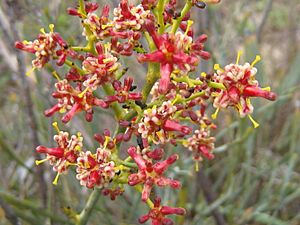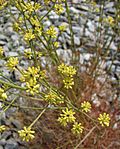Blueboy facts for kids
Quick facts for kids Blueboy |
|
|---|---|
 |
|
| Stirlingia latifolia flowering | |
| Scientific classification |
|
| Kingdom: | Plantae |
| Clade: | Tracheophytes |
| Clade: | Angiosperms |
| Clade: | Eudicots |
| Order: | Proteales |
| Family: | Proteaceae |
| Subfamily: | Proteoideae |
| Tribe: | Conospermeae |
| Subtribe: | Stirlingiinae L.A.S.Johnson & B.G.Briggs |
| Genus: | Stirlingia Endl. |
| Species | |
|
7 species; see text. |
|
Stirlingia, often called blueboy, is a group of 7 different plant types (species). They belong to the Proteaceae plant family. All of these plants grow only in Western Australia.
Contents
What do Stirlingia plants look like?
Stirlingia plants can be small shrubs or herbs. They grow from a strong, deep tap root or a woody base. Some Stirlingia plants are unique because they are herbs, which is rare for the Proteaceae family.
These plants can grow from about 10 centimetres (4 inches) to 1.5 metres (5 feet) tall. Their leaves feel soft and a bit like leather. They are split into two parts along their length. Most of the leaves grow on the lower parts of the stems.
The flowers of Stirlingia grow in groups called inflorescences. These groups can look like small heads or very short spikes.
How Stirlingia Got Its Name
The first time this group of plants was officially named was in 1810 by Robert Brown. He called them Simsia. Brown first described two types: Simsia anethifolia and Simsia tenuifolia. Later, in 1830, he added a third type, Simsia latifolia.
However, it was later found that the name Simsia was already used for another plant group in 1807. So, in 1838, a botanist named Stephan Endlicher had to give the plants a new name. He chose Stirlingia. This name was chosen to honor James Stirling. He was an explorer of the Swan River area and the first Governor of Western Australia.
Over the years, many botanists studied these plants. They added new types and sometimes changed the names. For example, John Lindley added Stirlingia paniculata and Stirlingia simplex in 1838. Later, Ernst Steudel moved Brown's original types to the new Stirlingia name, like Stirlingia latifolia.
In 1995, Alex George wrote a detailed book about Stirlingia for the Flora of Australia series. He helped to sort out all the different names. He also added one new type, Stirlingia divaricatissima.
Types of Stirlingia Plants
Today, there are seven types (species) of Stirlingia plants that are officially recognized:
| Image | Scientific name | Distribution |
|---|---|---|
| Stirlingia abrotanoides | Found in the Wheatbelt region of Western Australia. | |
| Stirlingia anethifolia | Grows in Western Australia. | |
| Stirlingia divaricatissima | Found in Western Australia. | |
| Stirlingia latifolia | Found in the Southwest Botanical Province, from Kalbarri in the north to Albany in the south. | |
| Stirlingia seselifolia | Grows in the South West and Great Southern regions of Western Australia. | |
 |
Stirlingia simplex | Found in the Southwest Botanic Province of Western Australia. |
| Stirlingia tenuifolia | Grows in Western Australia. |
The common name Blueboy is sometimes used for the whole group of plants. But it most often refers to the specific type called S. latifolia. This name comes from a surprising fact: if wall plaster is made using sand from where S. latifolia grows, the plaster can turn blue!
Where Stirlingia Plants Live
All Stirlingia plants grow only in the Southwest Botanical Province of Western Australia. They can be found in different kinds of soil, including sand, clay, and laterite (a type of reddish soil). Most types prefer low-lying areas that get wet during certain times of the year.
Stirlingia and the Environment
Even though none of the Stirlingia types are officially listed as rare, S. divaricatissima is listed as "Priority Three - Poorly Known Taxa." This means that the Department of Environment and Conservation is keeping an eye on it because not much is known about how many of these plants exist.
See also
 In Spanish: Stirlingia para niños
In Spanish: Stirlingia para niños

